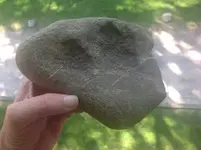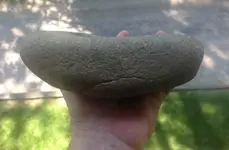Gold Maven
Bronze Member
- Joined
- Jul 4, 2012
- Messages
- 2,319
- Reaction score
- 2,186
- Golden Thread
- 0
- Location
- Holmes County Ohio
- Detector(s) used
- Tesoro Lobo
- Primary Interest:
- All Treasure Hunting
It's not too often that a new discovery takes takes place regarding the actual use of a prehistoric tool.
In the fall issue of the Ohio Archaeologist, Scot Stoneking presents a new theory concerning the Cupstone.
I have found a few over the years, with many shallow cups, I was told, and read, where nuts were cracked there until the cup became too deep, and then another hole was started.
This never made sense to me, why would you need a cup to hold the nut? the cups were always shallow too, so that a nut wouldn't get stuck. I never really bought the story, but I had nothing better.....'till now.
The article is very detailed, and my hunt and peck typing skills prevent me from copying the entire article.
The gist of it is, the author is a flint knapper, and concluded that the cups are from dressing antler billets used in the flint knapping process. He goes into detail about why the antler billet has to be continuously dressed, and it makes perfect sense. He took a sandstone block, and by twisting the base of his antler he formed a cup, and dressed his tool perfectly in about a minute.
Very interesting, that this mystery has been solved.
Volume 63 no.4 Fall 2013
Ohio Archaeologist mag.
In the fall issue of the Ohio Archaeologist, Scot Stoneking presents a new theory concerning the Cupstone.
I have found a few over the years, with many shallow cups, I was told, and read, where nuts were cracked there until the cup became too deep, and then another hole was started.
This never made sense to me, why would you need a cup to hold the nut? the cups were always shallow too, so that a nut wouldn't get stuck. I never really bought the story, but I had nothing better.....'till now.
The article is very detailed, and my hunt and peck typing skills prevent me from copying the entire article.
The gist of it is, the author is a flint knapper, and concluded that the cups are from dressing antler billets used in the flint knapping process. He goes into detail about why the antler billet has to be continuously dressed, and it makes perfect sense. He took a sandstone block, and by twisting the base of his antler he formed a cup, and dressed his tool perfectly in about a minute.
Very interesting, that this mystery has been solved.
Volume 63 no.4 Fall 2013
Ohio Archaeologist mag.
Amazon Forum Fav 👍
Upvote
0





